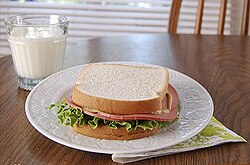
Back Sandwich ALS Sandwīc (ǣt) ANG شطيرة Arabic Sándwich AST Saniwitc ATJ Sendviç Azerbaijani ساندویچ AZB Сэндвич Bashkir Sandwich BCL Roti tumplek BEW
 | |
| Main ingredients | Bread, meat, cheese, salad vegetables and sauce or spread |
|---|---|
A sandwich is a dish typically consisting of vegetables, sliced cheese or meat, placed on or between slices of bread, or more generally any dish wherein bread serves as a container or wrapper for another food type.[1][2][3] The sandwich began as a portable, convenient finger food in the Western world, though over time it has become prevalent worldwide.
In the 21st century there has been considerable debate over the precise definition of sandwich, and specifically whether a hot dog or open sandwich can be categorized as such. In the United States, the Department of Agriculture and the Food and Drug Administration are the responsible agencies. The USDA uses the definition, "at least 35% cooked meat and no more than 50% bread" for closed sandwiches, and "at least 50% cooked meat" for open sandwiches.[4] However, the same USDA manual determines the burritos and fajitas are "sandwich-like", and frankfurters are "sandwich type". Stromboli is explicitly excluded from being a sandwich. In Britain, the British Sandwich Association defines a sandwich as "any form of bread with a filling, generally assembled cold", a definition which includes wraps and bagels, but excludes dishes assembled and served hot, such as burgers.[5]
Sandwiches are a popular type of lunch food, taken to work, school, or picnics to be eaten as part of a packed lunch. The bread may be plain or be coated with condiments, such as mayonnaise or mustard, to enhance its flavour and texture. As well as being homemade, sandwiches are also widely sold in various retail outlets and can be served hot or cold.[6][7] There are both savoury sandwiches, such as deli meat sandwiches, and sweet sandwiches, such as a peanut butter and jelly sandwich.
The sandwich is named after its supposed inventor, John Montagu, 4th Earl of Sandwich.[8][9] The Wall Street Journal has described it as Britain's "biggest contribution to gastronomy".[10]
- ^ Abelson, Jenn (10 November 2006). "Arguments spread thick". The Boston Globe. Archived from the original on 7 December 2008. Retrieved 27 May 2009.
- ^ "sandwich". Merriam-Webster. Archived from the original on 2 November 2021. Retrieved 29 March 2012.
- ^ Foundations of Restaurant Management & Culinary Arts Level Two. Pearson. 2011. p. 53. ISBN 978-0-13-138022-6.
- ^ Ludlow, Peter (2014). Living Words:Meaning Underdetermination and the Dynamic Lexicon. Oxford University Press. ISBN 978-0-19-871205-3. Archived from the original on 13 May 2023. Retrieved 19 March 2023.
- ^ "What is a Sandwich? | British Sandwich Week". British Sandwich & Food to Go Association. Archived from the original on 31 October 2023. Retrieved 18 May 2022.
The British Sandwich Association defines a sandwich as: Any form of bread with a filling, generally assembled cold – to include traditional wedge sandwiches, as well as filled rolls, baguettes, pitta, bloomers, wraps and bagels. [...] There is much debate as to what constitutes a sandwich but burgers and other associate products are not considered to be a sandwich.
- ^ Foundations of Restaurant Management & Cullinary Arts Level Two. Pearson. 2011. p. 53. ISBN 978-0-13-138022-6.
- ^ Becoming a Foodservice professional Year 1. National Restaurant Association Educational Foundation. 1999. p. 306. ISBN 1-883904-87-0.
- ^ What's Cooking America Archived 29 April 2015 at the Wayback Machine, Sandwiches, History of Sandwiches. 2 February 2007.
- ^ "Sandwich celebrates 250th anniversary of the sandwich". BBC News Online. 12 May 2012. Archived from the original on 29 December 2017. Retrieved 18 May 2012.
- ^ Marks, Kathy (17 May 1997). "BLT: British, lousy and tasteless". The Independent. London. Archived from the original on 10 June 2020. Retrieved 11 September 2017.
© MMXXIII Rich X Search. We shall prevail. All rights reserved. Rich X Search